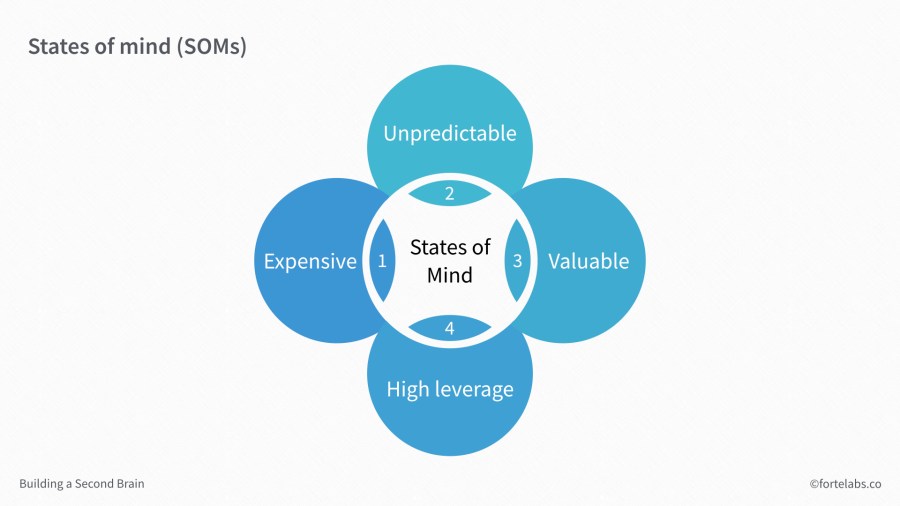
In Part 16, we refined our understanding of Return on Attention by taking into account our biggest constraint as knowledge workers – not just our attention but our deeply focused attention in particular.
But human attention is not a simple commodity like oil or gold. It can’t be stored in barrels or vaults or measured in liters or grams. Attention emerges from deep within the human psyche, which means that all aspects of human psychology come into play.
Luckily, we don’t need to understand the full complexity of our minds to become more effective at shaping and deploying our attention. We just need to learn how to manage our states of mind, each one representing a certain kind of attention applied in a certain context.
I believe that our states of mind have become our most important assets as knowledge workers. In an economy based on creativity, it is the state of mind that we enter through our creative process that is even more rare and valuable than any product or deliverable we produce while in it. Our ultimate competitive advantage is a way of thinking.
Because of this, it is worth designing a way of working that puts us in certain states of mind as often and for as long as possible, and leverages what we produce during that time into tangible results.
Let’s start with a definition for “state of mind.” A SOM is:
- difficult or expensive to reproduce (in contrast to simple emotions)
- illegible and more-than-the-sum-of-its-parts (in contrast to cause-and-effect habits)
- primarily somatic and affective, not intellectual (in contrast to belief systems or worldviews)
- temporary and ephemeral (in contrast to mindsets or attitudes)
In the past, SOMs were often treated as a threat in the workplace. The path to success was clear and obvious – it was just a matter of staying consistent and getting yourself to walk it. In this context, how you were feeling was a distraction. Finding yourself in lazy, contemplative, social, or creative state of mind threatened to knock you off your well-laid path. Thus your emotions, moods, intuitions, ideas, and needs were best avoided or suppressed.
But working with way no longer makes any sense, because the future you’re counting on isn’t going to happen. There is no path to be discovered; there is a path to be made. “Making a path” is the new “finding yourself.”
Making such a path is not a linear, step by step process, like laying one stone after another. Because the path exists only in your mind, it can bend and break, reshape and reform at a moment’s notice. It is an act of pure creation. Each and every one of you is an artist, and your greatest masterpiece is your future.
On this journey, your states of mind are your most precious resource, because they are the surface evidence of what’s happening in the deep underground channels of your psyche. Within these channels move your fears and your doubts, but also your highest dreams, deepest passions, and most intense sources of meaning and energy.
For the first time in history, you can’t succeed just by putting your head down and grinding through a few decades of work. To succeed in a creativity-driven economy, you need to get to know yourself, getting down to the bedrock of who you are and what matters to you. Self-awareness and personal growth are now aligned with effectiveness and success. In fact, personal growth is now your #1 job, because it is the only thing that can never be outsourced.
Qualities of SOMs
There are a few important things to understand about states of mind. They are:
- Expensive
- Unpredictable
- Valuable
- High leverage
EXPENSIVE
States of mind are expensive – often requiring long spans of time, certain substances, rituals, or environments to reproduce. It takes real resources to take a week off for a meditation retreat to gain some perspective. It has real costs to cancel meetings for a day of strategic planning. It isn’t cheap to hire an assistant so you can spend more time in flow.
UNPREDICTABLE
States of mind are unpredictable – they come and go as they please. Just because they happen in your mind, that doesn’t mean you can control them. You can set up all the right conditions, and your desired state may never come. You may love the thrill of close collaboration with your team, but trying to force it will only kill it. You have to let it emerge.
VALUABLE
States of mind are also very valuable. They can’t be easily imitated, because they arise from a complex intersection of one’s past, personality, intuition, affinities, and bodily states. They’re not easily transferred from one person to another. A master wood carver may teach everything he knows to an apprentice, but he can’t communicate the state of mind of being a master wood carver. The apprentice will need to gain those years of experience himself.
HIGH LEVERAGE
States of mind give us tremendous leverage, because they dramatically influence how much energy it takes to complete a given task. When you’re in Errand Mode, running an additional errand doesn’t take much extra energy. But if you’re in the middle of a deep focus session, even the simplest errand can feel like a harsh imposition.
The research strongly backs up the theory that states of mind are both rare and valuable. This HBR report and this Scientific American article describe studies showing that unusually creative people are characterized by “their ability to mix seemingly incompatible states of being depending on the task, whether it’s open attention with a focused drive, mindfulness with daydreaming, intuition with rationality, intense rebelliousness with respect for tradition, etc.” (also called “blends of emotions”). Affective engagement — the extent to which people are open to the full breadth and depth of their emotions — was found to be a better predictor of artistic creativity than IQ or intellectual engagement.
The bottom line is that states of mind are not just cool trips, but concrete competitive assets. The more states you have access to, and the better you are at juggling them from situation to situation, the higher your chances of producing work that no one else can produce.
Follow us for updates on Twitter, Facebook, Instagram, LinkedIn, or YouTube.
The Only Subscription
You Need to
Stay at the
Edge of AI
The essential toolkit for those shaping the future
"This might be the best value you
can get from an AI subscription."
- Jay S.
Join 100,000+ leaders, builders, and innovators

Email address
Already have an account? Sign in
What is included in a subscription?
Daily insights from AI pioneers + early access to powerful AI tools








Comments
Don't have an account? Sign up!